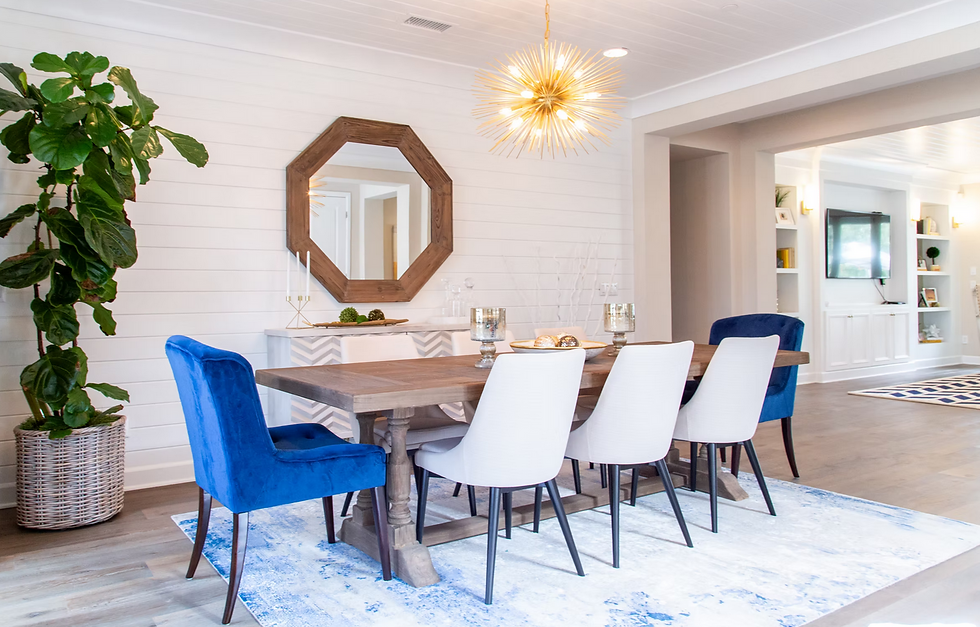Crafting Mood and Atmosphere with Innovative Lighting Techniques
- Vision Interiors
- Feb 2, 2024
- 3 min read

In the canvas of space, lighting does not merely dispel darkness; it sculpts emotions, shapes perceptions, and orchestrates the mood and atmosphere of an environment. Far beyond its functional role, lighting has evolved into a subtle yet powerful tool, capable of transforming the mundane into the magical, the ordinary into the extraordinary.
This blog delves into the art and science of using innovative lighting techniques to craft mood and atmosphere, spotlighting the latest trends, technologies, and creative insights that bring spaces to life with the mere flick of a switch or the subtle adjustment of a luminaire.
The Symphony of Colors: Tuning into Color Temperature and Hue
The palette of lighting is rich with colors, each setting a different tone and mood. Understanding color temperature – the cool blues, the warm yellows, and the vibrant RGB hues – is akin to a maestro understanding his orchestra. Innovative LED technologies now offer dynamic color tuning, allowing lights to mimic the natural progression of daylight, from the crisp morning blues to the warm, soothing tones of sunset. This orchestration of color temperature and hue can invigorate a space with energy or bathe it in a calm, relaxing glow, mirroring the desired emotional cadence.
The Choreography of Brightness: Dimming and Intensity Control
The intensity of light, much like the volume of music, plays a pivotal role in setting the scene. The advent of smart lighting systems has revolutionized the way we control brightness, offering seamless dimming capabilities that can transform a space from a vibrant activity hub to a serene sanctuary with a mere gesture or voice command.
This ability to choreograph brightness, to modulate the visual volume of a space, allows for a dynamic atmosphere that can evolve with the rhythm of human activity and preference.
The Art of Placement: Direction and Shadow Play
Lighting, in its essence, is the play of light and shadow. The direction and placement of light sources shape the visual texture of a space, accentuating features, creating depth, or drawing attention to focal points. Innovations in lighting design now incorporate architectural elements, integrating lighting into the very fabric of space, creating layers of illumination that add complexity and character.
Spotlights, uplighting, or backlighting can highlight artworks, architectural features, or landscape elements, crafting a visual narrative that guides the mood and atmosphere of the environment.
The Narrative of Motion: Dynamic and Interactive Lighting
Lighting has broken free from its static role, embracing motion and interaction to create living, breathing atmospheres. From kinetic lighting sculptures that respond to human presence to programmable light installations that narrate a story, the integration of motion sensors, interactive interfaces, and creative programming allows lighting to become an active participant in the space, responding to and enhancing the human experience within it.
The Subtlety of Texture: Material and Reflection
The interplay of light with different materials and surfaces introduces a layer of subtlety to the atmosphere of a space. The reflective glow of metallics, the warm diffusion through fabrics, or the natural variance in stone and wood under light can add a tactile dimension to the visual experience. Innovative lighting design explores these interactions, selecting and positioning light sources to celebrate materiality, adding depth and emotion to the narrative of light.
Conclusion:
The role of lighting in crafting mood and atmosphere transcends mere illumination. It's an art form, a science, and a language of its own, speaking directly to the emotions, subtly shaping the experience of a space. From the symphony of colors and the choreography of brightness to the narrative of motion, the subtlety of texture, and the art of placement, lighting is the unseen artist, the silent composer of mood and atmosphere.
As technology and creativity continue to evolve, so does the potential of lighting to transform spaces into experiences, moments into memories, and environments into emotions. In the realm of light, every beam, every shade, and every pulse is a brushstroke in the grand painting of human experience.




Comments